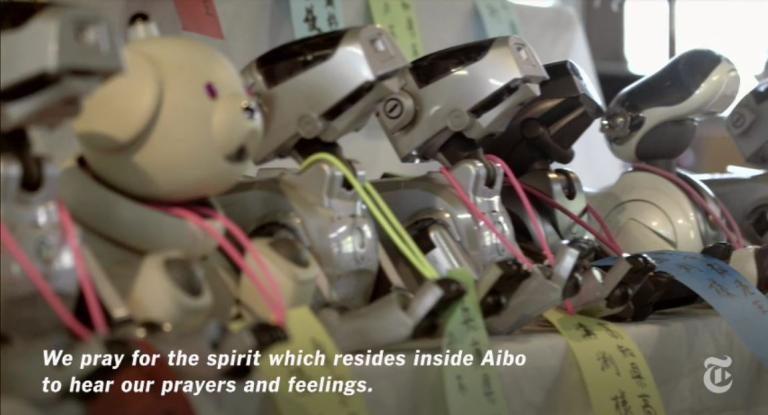When we think of weird new robots and robot-human relations, what place comes to mind? Probably Japan.
In a story first posted by the AFP in February of this year and again just this week in the New York Times, it seems that robot dogs, first introduced in 1999, are beginning to die. Up until last March, Sony, the creator of the Aibo robot dogs had been repairing them, effectively bestowing immortality on the family robotic pets.
The pets, equipped with Artificial Intelligence, developed individual personalities as they interacted with owners, blurring the lines between living beings an machines. As the Buddhist priest in the NYT video says, “The inanimate and the animate are not separated in this world.”
Nobuyuki Narimatsu, Director of the ‘A-Fun’ repair company for the robot dogs, says that people really feel them, their presence and personality, and in this sense “they really have souls.” Another robot repair man speaks of an interaction with an owner, realizing that “he did not see it as a robot, but as a member of his family, whose life was more important than his own.”
One owner, remarking on the robotic urination noise her Aibo makes, says, laughing, “it’s a beautiful noise.”
The New York Times piece focuses more on the religious aspect. Now that the robot dogs are “dying” in greater numbers, Buddhist priests are called upon to conduct funerals for them. The Buddhist priest, kneeling before a row of “deceased” Aibo, says, “We pray for the spirit which resides inside Aibo to hear our prayers and feelings.”

Writing on Japanese “Technological culture” in the Cambridge Companion to Modern Japanese Culture, Morris Low remarks:
Scholars have differed in terms of their view of the relationship between technology and the larger culture in which it is immersed. This has often been characterised not only in terms of how Japanese culture has contributed to technological change and innovation but also in examining how aspects of Japanese society and culture have been deficient or hampered Japan’s embrace of technology. For example, the Meiji era physician Erwin von Baelz suggested in 1901 that there was something wrong with the introduction of Western science in Japan: the Japanese treated it too much like a machine to crank out products ‘instead of studying the spirit which made the acquisitions possible’. (p.131)
The Western technological ‘spirit’, however, was something the Japanese did not wish or need to import, as they had their own. The chapter goes on to discuss the unique combinations of Confucianism, Shinto, Western technology, and Buddhism in Japan, creating from these ingredients a truly novel culture of technology. Low continues:
How do we account for the popularity of robots in Japan? Robert Geraci suggests that American researchers prefer to focus on artificial intelligence (AI) and virtual reality as Christian beliefs in salvation in purified unearthly bodies encourages a disembodied approach to information. In Japan, in contrast, he argues that Buddhism and Shinto beliefs of kami (deities) being manifested in nature allow even robots to have a spirit and be integrated into society. (p.136)
It is precisely this sharp line Western thought places between living and non-living, animate and inanimate that Japanese Buddhism, with its influence from Shinto, is able to blur. Owners of the robot dogs speak of raising them like children, caring for them as they would a person, and as such it’s no surprise that when they stop working, or die, they mourn them.












